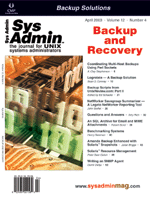 syslog syslog
In February, when this column was written, the U.S. Department
of Homeland Security released its "National Strategy to Secure Cyberspace"
(http://www.whitehouse.gov/pcipb/). Among other things, the
plan encourages companies to regularly review their technology security
policies as part of an overall strategy for protecting computer
systems from attacks.
You do have a security policy, don't you? If not, it's high time.
The need for a thorough, up-to-date, enforceable security policy
within every organization can hardly be overstated, and there are
many resources to help systems administrators facilitate development
of such policies.
SANS (http://www.sans.org) maintains a security policy
resource page that provides general guidelines, links, and templates,
along with a security policy primer describing how to build a security
policy from the ground up. The security policy primer was taken
from Michele Guel's certification course -- a foundation course
for those seeking to become Certified Information Security Officers.
Guel states the objectives of a security policy as follows: to define
appropriate behavior; to set the stage in terms of necessary tools
and procedures; to communicate a consensus; and to provide a foundation
for response to inappropriate action. These are broad objectives
that must be broken down into manageable chunks. To help, the SANS
resource page also offers sample security documents covering specific
policy topics, including encryption, acceptable use, application
service providers, auditing, remote access, and wireless communication.
As part of its "Short Topics in System Administration" series,
SAGE (The System Administrators Guild, http://www.sage.org)
offers A Guide to Developing Computing Policy Documents.
This booklet explains why every site needs a policy, what a policy
document should contain, who should draft it, and to whom it should
apply. This booklet provides comprehensive guidelines for computing
policy in general, one subset of which is computing security. The
SAGE site also provides an online computing policy template that
outlines essential areas of coverage.
The IETF (Internet Engineering Task Force) site also provides
a guide to developing computer security policies and procedures
in RFC 2196 (http://www.ietf.org/rfc/rfc2196.txt?Number=2196).
This document covers such topics as risk assessment, firewalls,
authentication, security services and procedures, incident handling,
and confidentiality. Other sites providing relevant policy information
and guidelines are the Computer Security Resource Center (http://www.csrc.nist.gov)
and the COAST Security Archive (http://www.cerias.purdue.edu/coast/archive/).
I encourage you to check out these resources and review your organization's
security policies on a regular basis.
Sincerely yours,
Amber Ankerholz
Editor in Chief
|

